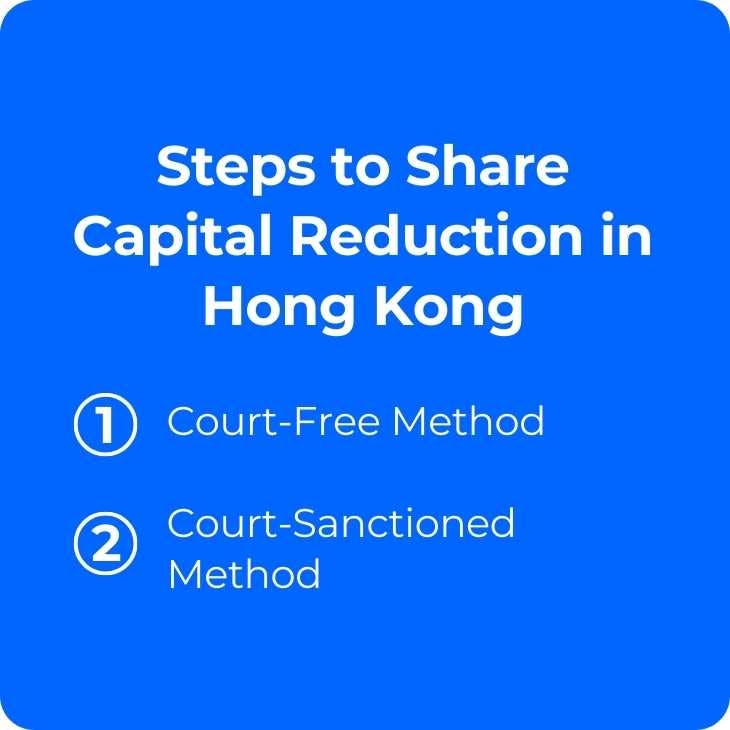Reduction must be approved by the board and shareholders.
Companies must file all required documents with the Registrar of Companies.
The process can take over a month but brings real financial and operational benefits.
Companies often use it to cut costs, return surplus capital, or adjust ownership structure.
In Hong Kong, the process for reducing share capital is governed by the Companies Ordinance (Cap. 622). It applies mostly to private companies limited by shares. Reducing share capital can help cut down costs, simplify ownership, or return extra funds to shareholders. While the process is straightforward, it must follow strict legal steps.
Share Capital Reduction Overview
Share capital refers to the value of a company’s issued shares.
Reducing share capital means lowering that value, either by cancelling shares, reducing the nominal value of shares, or repaying shareholders. This process is common in Hong Kong among both startups and established companies.
Startups may use it to reduce costs tied to unnecessarily high share capital, while larger businesses may use it for restructuring.
It often takes around one month, but sometimes more time is needed. It must follow very strict procedures for the changes to register correctly on the company's records.
Steps to Share Capital Reduction in Hong Kong
The procedures are laid out under the Companies Ordinance (Cap. 622). Companies can reduce share capital through two main routes:
- Court-free method
- Court-sanctioned method
Each route has its own rules and is suited for different situations.

Court-Free Method
This is the faster and simpler route. It’s only available if the company is solvent and there are no creditor objections.
Conditions:
- The company must be able to pay its debts for at least 12 months after the reduction.
- Directors must sign a written solvency statement confirming this.
- A special resolution must be passed by shareholders.
- Notices must be published and objections allowed.
Steps:

- Board Meeting and Solvency Statement
Directors approve the reduction and confirm solvency in writing.
- Shareholders’ Meeting
A special resolution is passed (typically requires 75% approval).
- Publication of Notice
The company publishes a notice in the Hong Kong Gazette and notifies creditors.
- Objection Period
Creditors and non-approving shareholders have five weeks to raise objections in court.
- Registrar Filing
If no objection is raised (or objections are overruled), the company submits final documents to the Registrar.
Once approved, the reduction takes effect.
Court-Sanctioned Method
If the company isn’t solvent or if objections arise, the reduction must go through court.
This process takes longer and involves more oversight, but is necessary in more complex or high-risk cases.
Steps:

- Petition to the Court
The company files a formal application explaining the reduction.
- Court Hearing
The court reviews the proposal and hears any objections from creditors or shareholders.
- Court Order
If satisfied, the court approves the reduction and issues an order.
- Registrar Filing
The company files the court order and supporting documents with the Registrar of Companies.
Use this method if your company has solvency issues, faces objections, or the restructuring is complicated.
Important Things for Directors to Consider
Before approving a capital reduction, directors should consider whether the company still needs its existing capital, for example, to maintain licenses, meet trading requirements, or support operations.
Directors should also decide how much capital to reduce and whether returning it to shareholders is in the company’s best interest.
Although an auditor’s report is not required, it may still be wise to have a professional accountant review the company’s financial position before making any major decisions.
With that in mind, directors should carefully consider the following:
- Does the business need its current capital for licensing or contracts?
- How much capital should be returned or cancelled?
- Is this reduction in the company’s long-term interest?
- Should an accountant or legal advisor review the financials, even if no auditor’s report is required?
Why Reduce Share Capital?
Reducing share capital can serve several strategic and financial purposes for companies in Hong Kong:
- By reducing the number of issued shares, each remaining shareholder holds a larger portion of the company’s equity, useful in ownership restructuring or consolidation.
- If the company has excess capital or distributable reserves, a reduction can be used to return value to shareholders. This is often more tax-efficient than paying dividends.
- In some cases, statutory fees or compliance costs may be tied to share capital levels. Reducing share capital may help lower these expenses.
- A reduction can eliminate unnecessary share classes or streamline the company’s equity, making it more attractive to potential investors and easier to manage.
- A voluntary capital reduction—done while the company is financially healthy—may signal confidence in the company’s future performance and financial strength.
However, a reduction cannot be carried out with the intent to defraud creditors or rescue a company from insolvency. Such attempts are likely to be legally challenged or rejected by the court.
A share capital reduction under the Companies Ordinance (Cap. 622) requires board approval and a special resolution by shareholders.
Directors must sign a solvency statement confirming the company can pay its debts for the next 12 months.
The resolution and statement must be filed with the Companies Registry, triggering a five-week creditor objection period. If no objections arise, the reduction can be registered. The process typically takes at least one month.
Company Share Repurchases (Buybacks)
A share buyback is different from capital reduction.
Instead of reducing the number of shares through cancellation, the company repurchases its own shares from existing shareholders.
Also, share buyback is governed by Part 5 of the Companies Ordinance (Cap. 622).
Why Companies Buy Back Shares
- Capital Management – Helps adjust capital structure and reduce excess funds.
- Targeted Transactions – Allows purchase from specific shareholders under certain conditions.
- Market Signaling – Can show the company believes its stock is undervalued.
Buybacks must follow specific procedures, such as on-market, off-market, by employee scheme, or pursuant to a court order, and usually require shareholder approval and filings with the Companies Registry.
Conclusion
Reducing share capital can help cut costs or adjust ownership, but it must follow set rules. Air Corporate takes care of the full process—preparing documents, filing with the Companies Registry, and making sure everything is done properly.
Start with Air Corporate and keep your business on track.



